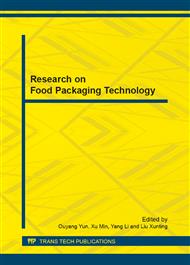[1]
Ahvenainen, R. (2003). Novel food packaging techniques, Woodhead Publishing in Food Science and Technology[M], Boca Raton; Cambridge, 50-95, 363-379.
Google Scholar
[2]
Zemlji, L. F., Tkavc, T., Vesel, A., et al. 2013. Chitosan coatings onto polyethylene terephthalate for the development of potential active packaging material. Applied Surface Science, 265(15), 697-703.
DOI: 10.1016/j.apsusc.2012.11.086
Google Scholar
[3]
Kim, S. K. (2011). Chitin, chitosan, oligosaccharides and their derivatives. New York: CRC Press, Taylor& Francis Group.
Google Scholar
[4]
Prashanth, H. K. V., Tharanathan, R.N., (2007). Chitin/Chitosan: modifications and their unlimited application potential-an overview. Trends in Food Science and Technology, 18(3), 117-131.
DOI: 10.1016/j.tifs.2006.10.022
Google Scholar
[5]
Kanatt, S.R., Chander, R., Sharma, A., (2008). Chitosan and mint mixture: a new preservative for meat and meat products. Food Chemistry, 107(2), 845-852.
DOI: 10.1016/j.foodchem.2007.08.088
Google Scholar
[6]
Soultos, N., Tzikas, Z., Abrahim, A., et al. (2008). Chitosan effects on quality properties of Greek-style fresh pork sausages. Meat Science, 80(4), 1150-1156.
DOI: 10.1016/j.meatsci.2008.05.008
Google Scholar
[7]
Giatrakou, V., Ntzimani, A., Zwietering, M., et al. (2010). Combined chitosan thyme treatments with modified atmosphere packaging on a Greek Ready-to-Cook (RTC) poultry product. Journal of Food Protection, 73, 663-669.
DOI: 10.4315/0362-028x-73.4.663
Google Scholar
[8]
Yan Jiang, Huijuan Bao, Jiaqi Liu, et al. (2013). Preparation of chitosan-PE antimicrobial bi-layer films and antibacterial activity. Food Science and Technology, Accepted.
Google Scholar
[9]
ASTM Standards, D882-09. (2009). Standard test method for tensile proper-ties of thin plastic sheeting. West Conshohocken, PA: ASTM International. http: /dx. doi. org/10. 1520/D0882-09, www. astm. org.
Google Scholar
[10]
Gennadios, A., Weller, C. L., Gooding, C. H. (1994). Measurement errors in water vapor permeability of highly permeable, hydrophilic edible films. J. Food Eng., 21, 395-409.
DOI: 10.1016/0260-8774(94)90062-0
Google Scholar
[11]
Zhao Hanyi. (2012). Antioxidant and antibacterial effects of Origanum essential oil in vitro. Chongqing: Xinan University.
Google Scholar
[12]
Y Ruiz-Navajas, M Viuda-Martos, E Sendra, et al. (2013). In vitro antibacterial and antioxidant properties of chitosan edible films incorporated with Thymus moroderi or Thymus piperella essential oils. Food Control, 30, 386-392.
DOI: 10.1016/j.foodcont.2012.07.052
Google Scholar
[13]
Aguirre, A., Borneo, R., Leon, A. E. (2013). Antimicrobial, mechanical and barrier properties of triticale protein films incorporated with oregano essential oil. Food Bioscience, 1, 2-9.
DOI: 10.1016/j.fbio.2012.12.001
Google Scholar
[14]
Atars, L., DeJesus, C., Talens, P., et al. (2010). Characterization of SPI-based edible films incorporated with cinnamon or ginger essential oils. Journal of Food Engineering, 99, 384-391.
DOI: 10.1016/j.jfoodeng.2010.03.004
Google Scholar
[15]
Kurek, M., Scrtar, M., Voilley, A., et al. (2012). Barrier properties of chitosan coated polyrthylene[J]. Journal of Membrance Science, 403-404(1), 162-168.
DOI: 10.1016/j.memsci.2012.02.037
Google Scholar
[16]
Pérez-Jiménez J, Arranz S, Tabernero M, et al. (2008). Updated methodology to determine antioxidant capacity in plant foods, oils and beverages: extraction, measurement and expression of results. Food Research International, 41(3), 274-285.
DOI: 10.1016/j.foodres.2007.12.004
Google Scholar
[17]
Pelissari, F., Grossman, M. V. E., Yamashita F, et al. (2009).
Google Scholar


